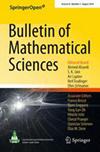Propagation and reaction–diffusion models with free boundaries
IF 2.5
2区 数学
Q1 MATHEMATICS
引用次数: 4
Abstract
In this short survey, we describe some recent developments on the modeling of propagation by reaction-differential equations with free boundaries, which involve local as well as nonlocal diffusion. After the pioneering works of Fisher, Kolmogorov–Petrovski–Piskunov (KPP) and Skellam, the use of reaction–diffusion equations to model propagation and spreading speed has been widely accepted, with remarkable progresses achieved in several directions, notably on propagation in heterogeneous media, models for interacting species including epidemic spreading, and propagation in shifting environment caused by climate change, to mention but a few. Such models involving a free boundary to represent the spreading front have been studied only recently, but fast progress has been made. Here, we will concentrate on these free boundary models, starting with those where spatial dispersal is represented by local diffusion. These include the Fisher–KPP model with free boundary and related problems, where both the one space dimension and high space dimension cases will be examined; they also include some two species population models with free boundaries, where we will show how the long-time dynamics of some competition models can be fully determined. We then consider the nonlocal Fisher–KPP model with free boundary, where the diffusion operator [Formula: see text] is replaced by a nonlocal one involving a kernel function. We will show how a new phenomenon, known as accelerated spreading, can happen to such a model. After that, we will look at some epidemic models with nonlocal diffusion and free boundaries, and show how the long-time dynamics can be rather fully described. Some remarks and comments are made at the end of each section, where related problems and open questions will be briefly discussed.具有自由边界的传播和反应扩散模型
在这篇简短的综述中,我们描述了用具有自由边界的反应微分方程来模拟传播的一些最新进展,其中包括局部和非局部扩散。在Fisher, Kolmogorov-Petrovski-Piskunov (KPP)和Skellam的开创性工作之后,使用反应扩散方程来模拟繁殖和传播速度已被广泛接受,并在几个方向取得了显着进展,特别是在异质介质中的繁殖,包括流行病传播的相互作用物种模型,以及气候变化引起的变化环境中的繁殖,等等。这种用自由边界来表示扩张锋的模式直到最近才被研究过,但进展很快。在这里,我们将集中讨论这些自由边界模型,从那些由局部扩散表示空间扩散的模型开始。其中包括具有自由边界的Fisher-KPP模型和相关问题,其中将检查一维和高空间维情况;它们还包括一些具有自由边界的两种种群模型,其中我们将展示如何完全确定某些竞争模型的长期动态。然后,我们考虑具有自由边界的非局部Fisher-KPP模型,其中扩散算子[公式:见文本]被包含核函数的非局部算子取代。我们将展示一种被称为加速扩散的新现象是如何发生在这样一个模型上的。之后,我们将研究一些具有非局部扩散和自由边界的流行病模型,并展示如何能够相当充分地描述长期动力学。在每一节的结尾处作一些评论和评注,其中将简要讨论相关的问题和悬而未决的问题。
本文章由计算机程序翻译,如有差异,请以英文原文为准。
求助全文
约1分钟内获得全文
求助全文
来源期刊

Bulletin of Mathematical Sciences
MATHEMATICS-
CiteScore
2.10
自引率
0.00%
发文量
17
审稿时长
13 weeks
期刊介绍:
The Bulletin of Mathematical Sciences, a peer-reviewed, open access journal, will publish original research work of highest quality and of broad interest in all branches of mathematical sciences. The Bulletin will publish well-written expository articles (40-50 pages) of exceptional value giving the latest state of the art on a specific topic, and short articles (up to 15 pages) containing significant results of wider interest. Most of the expository articles will be invited.
The Bulletin of Mathematical Sciences is launched by King Abdulaziz University, Jeddah, Saudi Arabia.
 求助内容:
求助内容: 应助结果提醒方式:
应助结果提醒方式:


